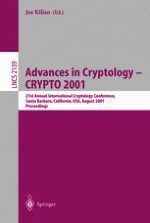2001 | OriginalPaper | Buchkapitel
Secure Distributed Linear Algebra in a Constant Number of Rounds
verfasst von : Ronald Cramer, Ivan Damgård
Erschienen in: Advances in Cryptology — CRYPTO 2001
Verlag: Springer Berlin Heidelberg
Enthalten in: Professional Book Archive
Aktivieren Sie unsere intelligente Suche, um passende Fachinhalte oder Patente zu finden.
Wählen Sie Textabschnitte aus um mit Künstlicher Intelligenz passenden Patente zu finden. powered by
Markieren Sie Textabschnitte, um KI-gestützt weitere passende Inhalte zu finden. powered by
Consider a network of processors among which elements in a finite field K can be verifiably shared in a constant number of rounds. Assume furthermore constant-round protocols are available for generating random shared values, for secure multiplication and for addition of shared values. These requirements can be met by known techniques in all standard models of communication.In this model we construct protocols allowing the network to securely solve standard computational problems in linear algebra. In particular, we show how the network can securely, efficiently and in constant-round compute determinant, characteristic polynomial, rank, and the solution space of linear systems of equations. Constant round solutions follow for all problems which can be solved by direct application of such linear algebraic methods, such as deciding whether a graph contains a perfect match.If the basic protocols (for shared random values, addition and multiplication) we start from are unconditionally secure, then so are our protocols. Our results offer solutions that are significantly more efficient than previous techniques for secure linear algebra, they work for arbitrary fields and therefore extend the class of functions previously known to be computable in constant round and with unconditional security. In particular, we obtain an unconditionally secure protocol for computing a function f in constant round, where the protocol has complexity polynomial in the span program size of f over an arbitrary finite field.
